Seven Questions Over Breakfast with Benji Davies
 March 17th, 2015 by jules
March 17th, 2015 by jules
— From Jory John’s Goodnight Already! (Harper, December 2014)
(Click to enlarge)
— From The Storm Whale (Henry Holt, September 2014)
(Click to enlarge)
 I always open my “breakfast” illustrator interviews with art — but usually just one image. I have two images today, though, from British illustrator Benji Davies, because I couldn’t pick.
I always open my “breakfast” illustrator interviews with art — but usually just one image. I have two images today, though, from British illustrator Benji Davies, because I couldn’t pick.
The first image is from his latest illustrated book here in the States, Jory John’s Goodnight Already!, which was released at the tail end of last year.
And that second image? It’s from The Storm Whale, which Benji both wrote and illustrated and which was released last Fall here in the U.S. (2013 in the UK). I wrote about that book here at Kirkus last year, and I couldn’t get over then what a beautiful illustration the one above, in particular, is. (That happens also to be the U.S. cover for the book.) And I still can’t get over it. Scroll back up and take a moment to enlarge that illustration and soak it in. Ah.
So that’s why I have two Benji art moments up there.
Benji—who, as you will read below, has been making picture books and board books for years now—is here for breakfast this morning. “Definitely with eggs,” he told me. “Preferably Benedict.” How’d he know I can’t start my day without eggs? Also, not without coffee. So, I’ll get that brewin’ while I get the basics from him before we chat over breakfast.
I thank him for visiting. (And if you want more, there’s Matthew Winner’s February podcast with Benji.)

Jules: Are you an illustrator or author/illustrator?
Benji: Both at once and the latter by itself.
Jules: Can you list your books-to-date? (If there are too many books to list here, please list your five most recent illustrated titles or the ones that are most prominent in your mind, for whatever reason.)
Benji: All books listed as published first in UK, unless shown.
(Click to enlarge)
As illustrator:
- On the Moon by Anna Milbourne, Usborne Publishing – 2004
- In the Castle by Anna Milbourne, Usborne Publishing – 2005
- On a Pirate Ship by Sarah Courtauld, Usborne Publishing – 2007
- Hodge the Hedgehog by Amy Sparkes, Meadowside Children’s Books – 2009
- When The Dragons Came by Lynne Moore and Naomi Kefford, Simon & Schuster – 2010
- Gruff’s Guide to Fairy Tale Land and Gruff’s Guide to the Secret Sea by Billy G. Gruff (and Amy Sparkes), Meadowside – 2011/13
- Bizzy Bear series (board books and apps) by Nosy Crow – 2011 to present
- Winston Was Worried by Pamela Duncan Edwards, Macmillan – 2012
- Jump On Board The Animal Train by Lynne Moore and Naomi Kefford, Simon & Schuster – 2012
- Railroad Hank by Lisa Moser, Random House (U.S.) – 2012
- Space Pirates series by Jim Ladd, Nosy Crow – 2013/14
- On Sudden Hill by Linda Sarah, Simon & Schuster – August 2014 (Big Friends in the U.S., Fall ’15, Henry Holt)
- Goodnight Already! by Jory John, Harper (U.S.) – Dec ’14
As illustrator — forthcoming:
- I Thought this Was A Bear Book – by Tara Lazar, Aladdin — August ’15
As author-illustrator:
- The Storm Whale — Simon & Schuster – August 2013 (U.S., September ’14, Henry Holt)
As author-illustrator — forthcoming:
- Grandad’s Island — Simon & Schuster – July 2015!
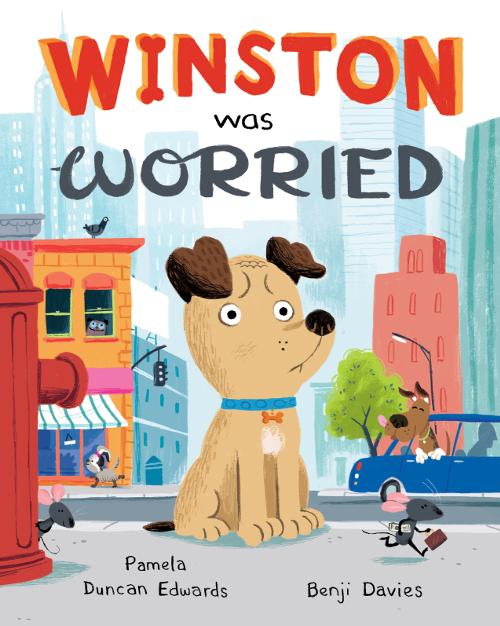
Jules: What is your usual medium?
Benji: Predominantly digital—Photoshop, using a Wacom—but I always sketch and do roughs in ink or pencil and sometimes incorporate that into my digital work, too.
(Click each to enlarge)
Jules: If you have illustrated for various age ranges (such as, both picture books and early reader books OR, say, picture books and chapter books), can you briefly discuss the differences, if any, in illustrating for one age group to another?
Benji: I have dipped into illustrating for picture, board, and chapter books.
I most enjoy illustrating my own texts, though, I think. There is a freedom to it, and I also find it the most fulfilling thing to see something that is my own creation, has only my name on the cover, on a bookshelf. Its a very proud feeling to have that achievement.
Jules: Where are your stompin’ grounds?
Benji I live in a part of northeast London in the UK, called Walthamstow.
but coming to the U.S. in Fall 2015 (Henry Holt) as Big Friends
(Click each to enlarge)
Jules: Can you briefly tell me about your road to publication?
Benji: I have been working in children’s illustration, making books for nearly ten years. I also spent several years simultaneously working as an animation director, creating commercials and music videos, until a couple of years ago when I got my first author commission and decided it was time to give children’s publishing my full attention.
(Click to enlarge)
(Click to enlarge)
— From The Storm Whale
(Click to enlarge)
(Click to enlarge)
(Click to enlarge)
Jules: Can you please point readers to your web site and/or blog?
Benji: benjidavies.com. Also twitter.com/Benji_Davies and facebook.com/benjidaviesdraws.
Jules: If you do school visits, tell me what they’re like.
Benji: They’re fun to do, and its great to interact with the kids and explore their imaginations. It’s amazing how unusual and interesting some of their ideas can be, and I try to encourage them, especially the ones who think their ideas are bad or that they can’t draw. They are usually the ones who don’t come up with the obvious stuff, and I like that.
that his dad would be angry about having a whale in the bath.”
(Click to enlarge)
He was glad his dad was there with him.”
(Click to enlarge)
(Click to enlarge)
Jules: Any new titles/projects you might be working on now that you can tell me about?
Benji: Goodnight Already! came out in the U.S. in December. I created an image for a book idea that my wife (who is not a writer but a fashion designer) came up with about a bear who couldn’t sleep. HarperCollins picked up on the image and the title I had given it but had other ideas for the words. (They weren’t so keen on the story she had written.) They got Jory John on board and asked him to write a story based on the cover image, which remains essentially as I had created in the original sample. The brilliantly funny text he wrote was a perfect fit to the characters. So it had a kind of back-to-front start in life. (My wife was fine with it, by the way!)
(Click to enlarge)
I’ve also recently completed artworking my second self-penned title. Its called Grandad’s Island and is about a little boy, called Syd, who discovers that when he goes up into the attic, his Grandad’s house becomes an old steam ship. It is also a story about losing his Grandad. I hope that it does this in a life-affirming way and could be empowering to a small child who reads it and has to deal with a similar situation to Syd. It’s already picked up several co-editions before publication, so that’s really exciting — and I hope it makes its way to the States soon.
I also have more in the works with Harper and Jory, an extension of the Goodnight Already! book into a series, and I’ve been working with Macmillan Children’s Books in the UK with an author called Elli Woollard on a really great book called The Giant of Jum.
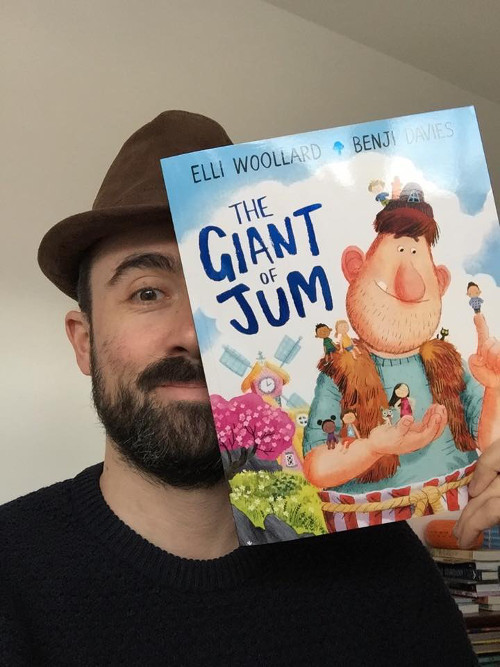
Its been an intense and busy time the past 18 months, and I’m looking forward to things easing up slightly towards the second half of 2015, so I can get a bit of breathing space and get down to writing and planning new projects.
 Okay, we’ve got our eggs, and it’s time to get a bit more detailed with six questions over breakfast. I thank Benji again for visiting 7-Imp.
Okay, we’ve got our eggs, and it’s time to get a bit more detailed with six questions over breakfast. I thank Benji again for visiting 7-Imp.
1. Jules: What exactly is your process when you are illustrating a book? You can start wherever you’d like when answering: getting initial ideas, starting to illustrate, or even what it’s like under deadline, etc. Do you outline a great deal of the book before you illustrate or just let your muse lead you on and see where you end up?
Benji: When illustrating for another author, I usually read the text a couple of times and then straight-away jot down my initial visual response — to get an immediate feel for how the book could look and feel. These seeds make it right through into the final book in one way or another. They might change a lot, some hardly at all. When I look back, I can see all the cues I created and what they led to. I often have to push myself to divert from this course or things can get too cliché, [meaning] I’m not pushing things as imaginatively as I could be. I have to look at what I’m doing and self-critique and think, where else I can take things, strengthen the concepts, or even step away and come back. I think a lot of the real work happens in these gaps, and they’re really important. Subconsciously, the brain is chipping away at a solution, but also consciously I am thinking about an image I am working on while I’m walking down the street or doing something unrelated, re-thinking the colours and the compostion — things like that. If I’m still struggling, I find at that stage it’s best to show the work to someone else — maybe my wife. She’s only a couple of rooms away in her studio, but then I’ll maybe email the book’s art director and editor, so they can shape and push things.
(Click to enlarge)
I go from loose ideas and sketches; to a full set of thumbnails, changes and re-thumbing; then full rough work, editorial changes to these before artworking; followed by colour tweaks and additional artworking. But all my books are different, and the process fluctuates. I like it like that. It keeps things interesting. I don’t like to be formal about it. Every project takes its own course.
(Click to enlarge)
When I write my own text, a lot of the process is similar, but the story comes together much more haphazardly. I might generate sketches that inform the beginning of a story or re-visit old ideas and put new life into them, taking them somewhere else. Or I might take photographs and collect visual references, make notes in the middle of the night on my phone or when I’m travelling. Theres no set way, but all these things gradually weave together and inform a story that has grown from both words and pictures. They are totally intertwined. I think of my stories as films playing in me head, and I pull ‘shots’ or beats from this mental movie and arrange them on the page.
see more information here …
(Click to enlarge)
2. Jules: Describe your studio or usual work space.
Benji: My studio is in the spare room of my house. I have two desks — one for drawing, one for computer work. I spend most of my time at the computer. I always wish I spent more time at the drawing table, which I mainly use for lightbox work.
3. Jules: As a book-lover, it interests me: What books or authors and/or illustrators influenced you as an early reader?
Benji: I still have some of my favourite books on the shelf here in the studio –- Frog and Toad by Arnold Lobel, The Tiger who came to Tea by Judith Kerr, The Little Grey Men by BB, Watership Down (actually, more the film than the book, which I read much later in my teens – I watched that film a hundred times, I still love it).
I also read all the Redwall books by Brian Jacques and lots of books by Dick King-Smith and Colin Dann. There’s a theme here – talking animals. When reading the Redwall books, I used to like to imagine them as hand-drawn animated films playing in my head as I read the words.
In terms of illustration, I loved anything highly detailed and intricate, books with cutaways of houses built inside tree stumps — that kind of thing. I loved visiting my local library after school. I found book illustration so absorbing; I would get into a cosy corner somewhere when I got home and just get lost in them.

4. Jules: If you could have three (living) authors or illustrators—whom you have not yet met—over for coffee or a glass of rich, red wine, whom would you choose? (Some people cheat and list deceased authors/illustrators. I won’t tell.)
Benji: I feel really lucky to have met and know a lot of my contemporaries and favourite artists, at least in the UK.
From the past: Tove Jansson. Present: Jon Klassen. Can I say an author-only too? Neil Gaiman. He seems very wise. I would probably not be able to speak.
5. Jules: What is currently in rotation on your iPod or loaded in your CD player? Do you listen to music while you create books?
Benji: I love listening to music, but equally I can go all day in silence and not realise.
I make soundtracks for a particular book and will collect together playlists, especially for my own author-illustrator work — tunes that help get my mind in the right mode of thought, emotionally or atmospherically. It can be anything and everything, but it tends to be more unusual electronic or classical stuff, or scores from films. Things that suit the mood of the project, so it often has to be really timeless or evocative to get the right tone.
I think I have quite a range of taste — from Led Zeppelin to Ryuichi Sakamoto. All sorts, really.

6. Jules: What’s one thing that most people don’t know about you?
Benji: I hate aquariums. I blame Jaws.
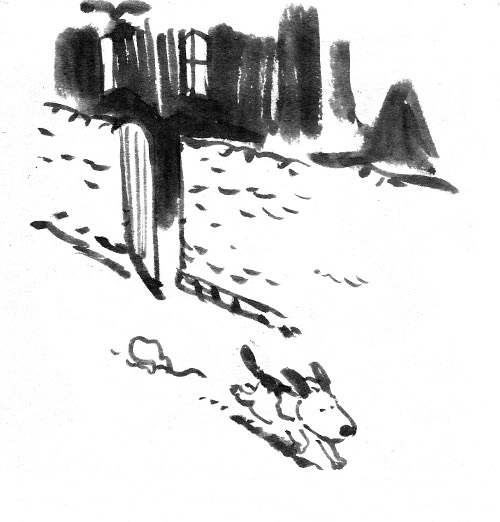
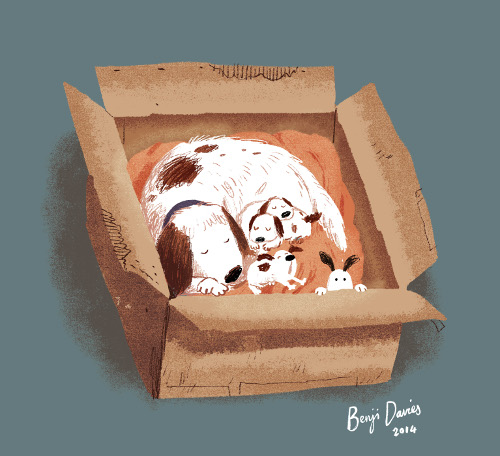

Jules: What is your favorite word?
Benji: I’m terrible with favourites. No, really. I can’t pick one.
Jules: What is your least favorite word?
Benji: Oh no. See above.
Jules: What turns you on creatively, spiritually or emotionally?
Benji: The natural world doing its thing.
Jules: What turns you off?
Benji: Ignorance.
Jules: What is your favorite curse word? (optional)
Benji: “Twonk.”
Jules: What sound or noise do you love?
Benji: Rain on the roof.
Jules: What sound or noise do you hate?
Benji: Cats fighting in the night.
Jules: What profession other than your own would you like to attempt?
Benji: Drummer.
Jules: What profession would you not like to do?
Benji: Cleaning windows on skyscrapers.
Jules: If Heaven exists, what would you like to hear God say when you arrive at the Pearly Gates?
Benji: “Did you remember to turn off the iron?”
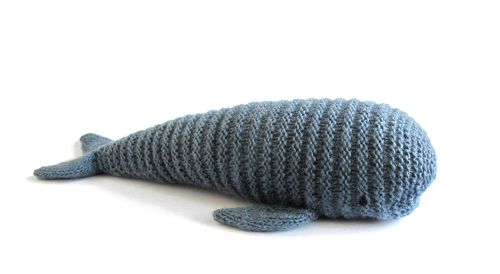
All images are used by permission of Benji Davies.
The spiffy and slightly sinister gentleman introducing the Pivot Questionnaire is Alfred, copyright © 2009 Matt Phelan.

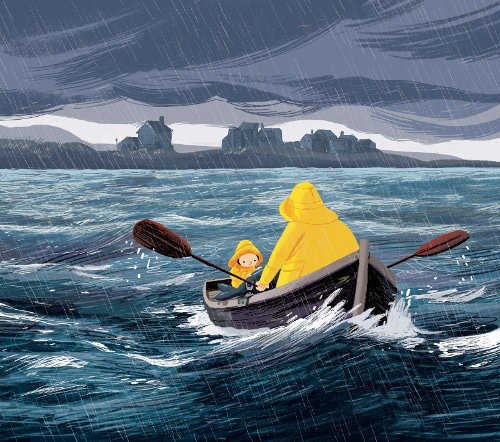

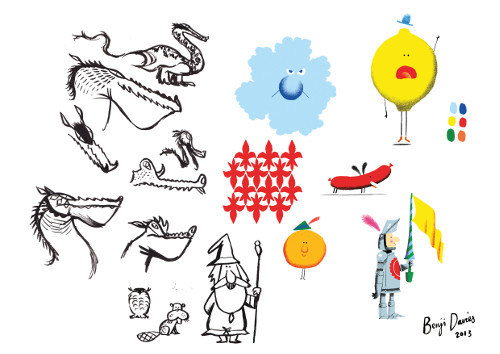




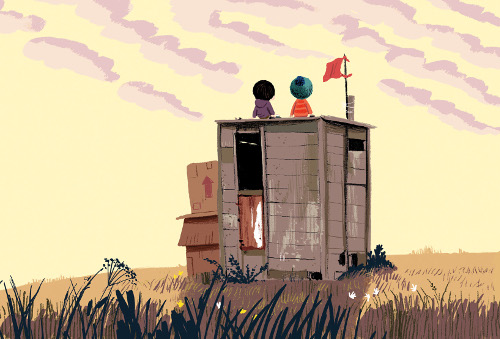
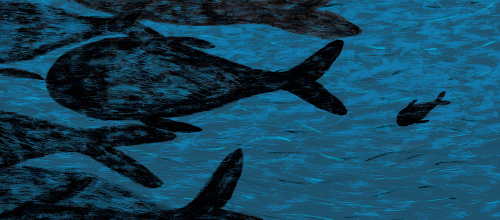
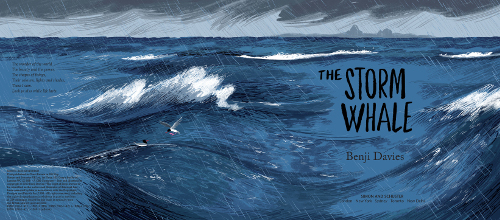

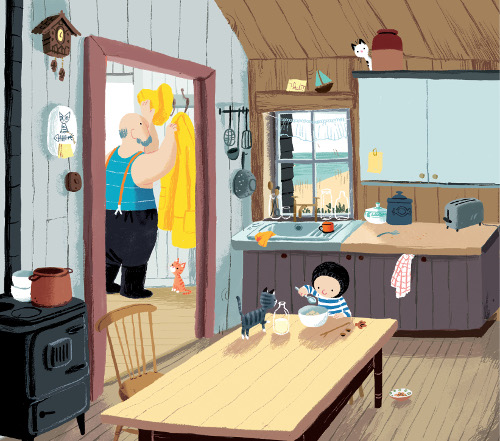
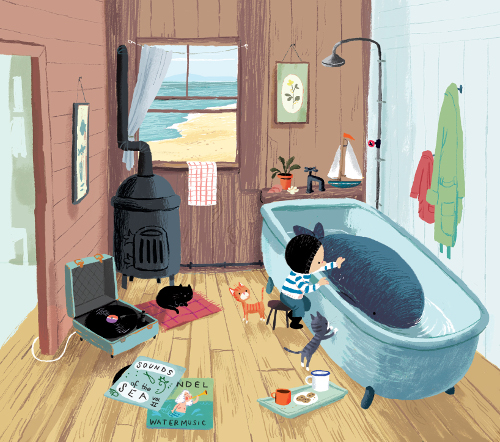

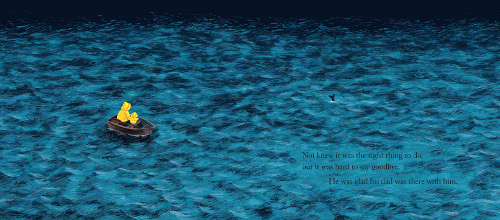



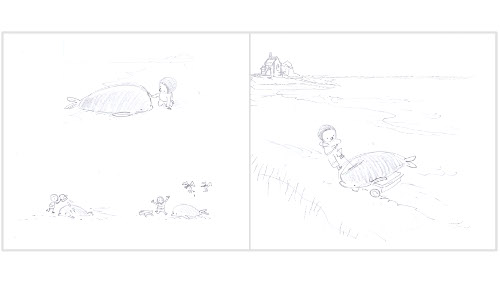


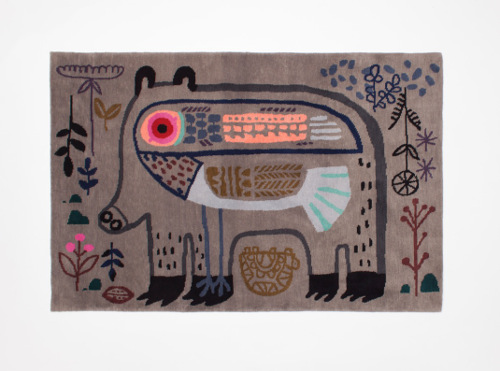
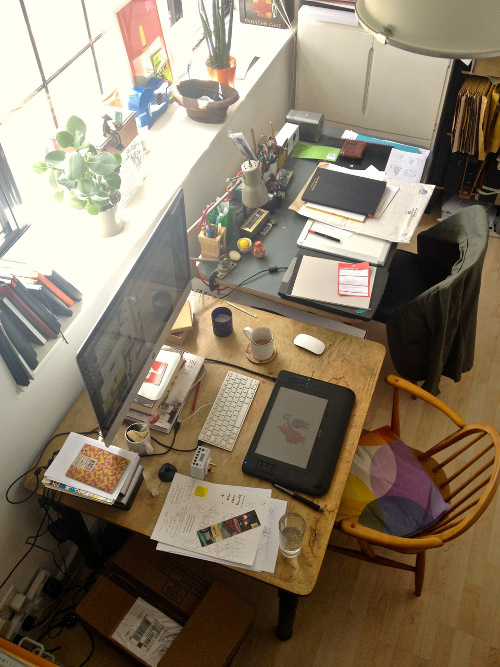
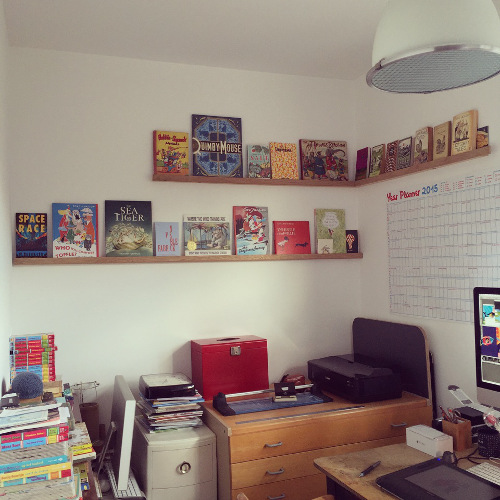
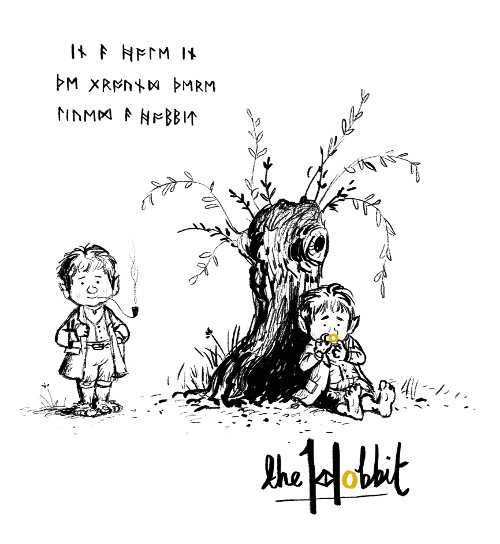
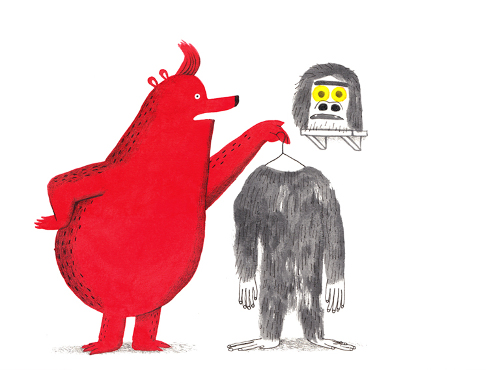
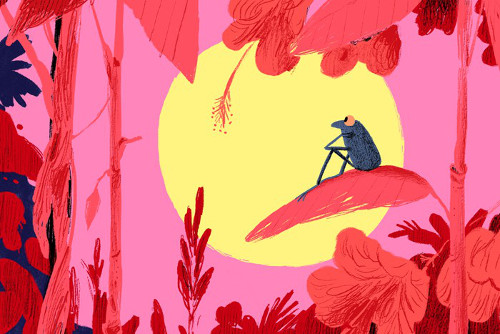


What an amazing interview! SO much fantastic stuff—the artwork is fantastic, some even breathtaking. The boys on the hill, the boat in the vast sea…oh, man.
Benji, love your work space 🙂 I’ve never heard of “twonk.” Wondering what the American equivalent is 😉 lol You would love RainyMood.com (and youtube videos of weather, ocean, etc.) and I’m thinking you need an iron with the “auto shut off” feature 🙂
Thank you both!
[…] here’s my March 2015 interview with Benji, if you want to see lots more […]
[…] kids’ book I purchased and read was Also An Octopus by Maggie Tokuda-Hall and illustrated by Benji Davies. Do you know it? It’s a beautifully illustrated story about the importance of stories and […]